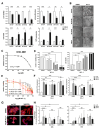Targeting KDM1A in Neuroblastoma with NCL-1 Induces a Less Aggressive Phenotype and Suppresses Angiogenesis
- PMID: 39458030
- PMCID: PMC11508765
- DOI: 10.3390/jcm13206081
Targeting KDM1A in Neuroblastoma with NCL-1 Induces a Less Aggressive Phenotype and Suppresses Angiogenesis
Abstract
Background: The KDM1A histone demethylase regulates the cellular balance between proliferation and differentiation, and is often deregulated in human cancers including the childhood tumor neuroblastoma. We previously showed that KDM1A is strongly expressed in undifferentiated neuroblastomas and correlates with poor patient prognosis, suggesting a possible clinical benefit from targeting KDM1A. Methods: Here, we tested the efficacy of NCL-1, a small molecule specifically inhibiting KDM1A in preclinical models for neuroblastoma. Results: NCL-1 mimicked the effects of siRNA-mediated KDM1A knockdown and effectively inhibited KDM1A activity in four neuroblastoma cell lines and a patient-representative cell model. KDM1A inhibition shifted the aggressive tumor cell phenotypes towards less aggressive phenotypes. The proliferation and cell viability was reduced, accompanied by the induction of markers of neuronal differentiation. Interventional NCL-1 treatment of nude mice harboring established neuroblastoma xenograft tumors reduced tumor growth and inhibited cell proliferation. Reduced vessel density and defects in blood vessel construction also resulted, and NCL-1 inhibited the growth and tube formation of HUVEC-C cells in vitro. Conclusions: Inhibiting KDM1A could attack aggressive neuroblastomas two-fold, by re-directing tumor cells toward a less aggressive, slower-growing phenotype and by preventing or reducing the vascular support of large tumors.
Keywords: LSD1; epigenetics; histone demethylase; pediatric cancer; targeted therapy.
Conflict of interest statement
The authors declare no potential conflicts of interest.
Figures




References
Grants and funding
LinkOut - more resources
Full Text Sources
Miscellaneous

